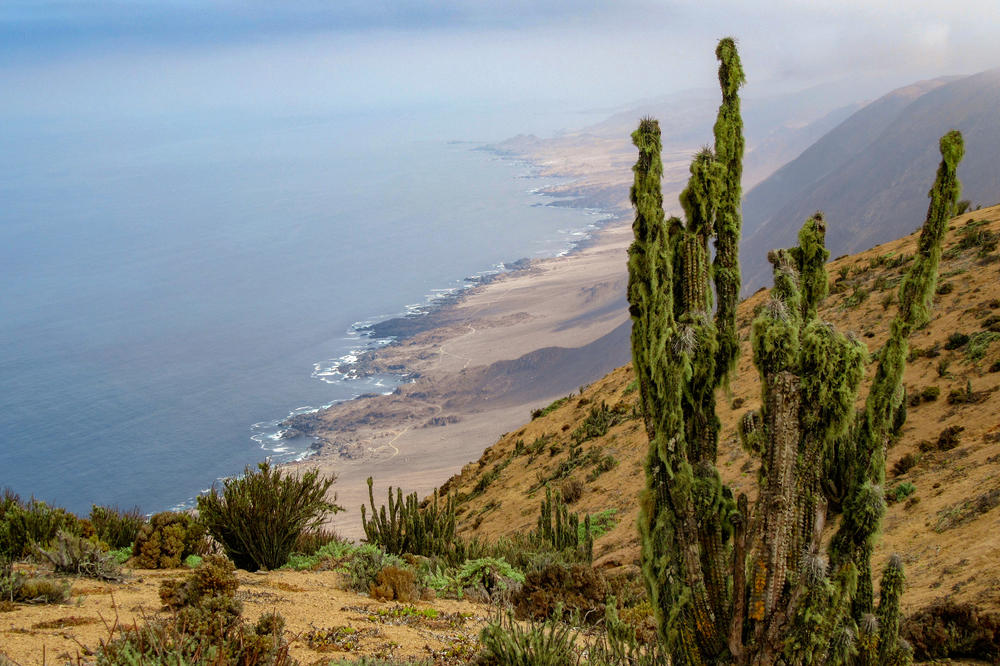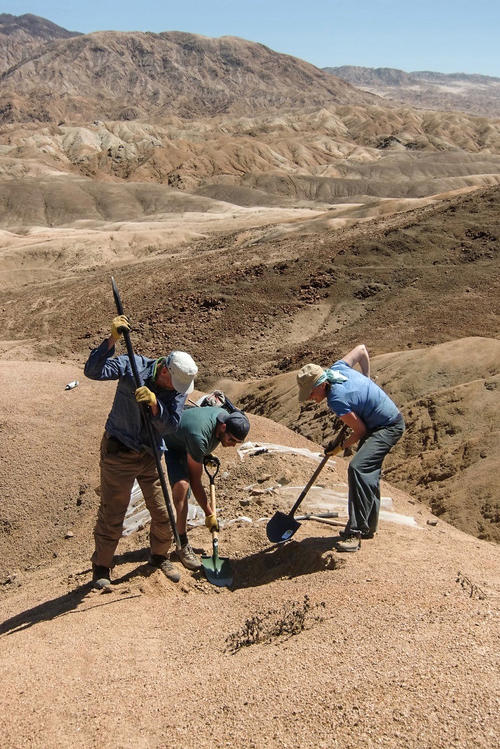The Skin of the Earth
In Chile, researchers from various disciplines are studying which forces have a bigger influence on the Earth’s surface – geological or biological ones. In the process, they are gleaning insights into possible consequences of climate change.
Dec 11, 2019
Extreme landscapes. On the cliffs of Chile’s Pan de Azúcar National Park, the world’s largest ocean, the Pacific, meets its driest desert, the Atacama. The cool Humboldt Current in the Pacific is what causes the dryness of the adjacent desert.
Image Credit: Friedhelm von Blanckenburg
The Earth’s surface has been shaped by opposing forces since time immemorial. Powerful processes occurring inside the planet lift the crust, and weathering, water, and deposits of organic substances such as the remains of plants give rise to soil. Climate-related erosion – by rain, wind, and glaciers – wears the soil away from the top down.
But there’s another force at work as well: biodiversity. To what extent do plants, animals, and microorganisms influence these two processes? Who shapes what? Does the biological world shape the geologic one, or vice versa? These interactions have been poorly understood so far.
In 2016, a team of 60 German researchers and 20 Chilean ones began investigating these questions as part of the EarthShape – Earth Surface Shaping by Biota priority program, which is receiving funding from the German Research Foundation (DFG). Chile is a perfect setting for this large-scale project, because the country’s coastal mountains extend north to south over 2000 kilometers, and the four nature parks where the teams are doing their research are located in very different climate zones.
With many climate zones, Chile is a perfect place for the research
“Pan de Azúcar, which is in the Atacama Desert, in the north, gets rain only once every ten years, and there’s almost no vegetation. In the southernmost location, in Nahuelbuta, we have a lush rainforest with torrential precipitation. Between them are Santa Gracia and La Campana, which form the transition between the two extremes,” says Friedhelm von Blanckenburg, a geochemist.
Von Blanckenburg is a professor at Freie Universität Berlin and the head of the Earth Surface Geochemistry section at the German Research Centre for Geosciences (GFZ) in Potsdam. He and Todd Ehlers, a geologist from the University of Tübingen, are responsible for coordinating the project, which is scheduled to run for six years.
The team includes geochemists, geophysicists, geomorphologists, and hydrologists, alongside experts in climate science, microbiology, soil ecology, and vegetation ecology. They are using weather stations, long-term photographic observation, aerial photos, deep drilling up to depths of 100 meters, soil profile samples, analyses of the DNA of microorganisms, geochemical measurements of soil and rock, and computer-assisted climate and vegetation models to explore the secrets of how the Earth's surface is formed. All this is taking place at all four locations at the same time.
From extremely arid to the kind of humidity generally found in the tropics, the climate gradient is reflected not just in the vegetation, but also in the morphology of the landscape. “In the south, where there is a lot of vegetation, we see broad slopes cradling flat valleys. In the north, on the other hand, there are more valleys, and they are steeper,” von Blanckenburg explains. Why is that? When the Atacama experiences one of its rare rainstorms, the rain falls heavily for a short time, swiftly washing sediment away down narrow gullies, while in the south, the forest canopy and the roots of the trees hold the soil in place.
In the desert, biologists have been studying various features, including rock coatings and soil crusts, coatings found on all kinds of rock. These are made up of algae and fungi that coexist in symbiotic relationships. “The algae supply the fungi with energy in the form of carbohydrates through photosynthesis. In return, the fungi release nutrients that are crucial to the algae, such as phosphorus, magnesium, calcium, and potassium, from the rock,” explains von Blanckenburg. “These chemical and biological processes ultimately also contribute to weathering.” In the humid south, these interactions between microbes and rock occur on a much larger scale; here, it is large trees that perform the photosynthesis, and a mesh of mycorrhizal fungi around their roots draws nutrients from the soil.
In addition to their research, the scientists have another task: breaking down the barriers between their disciplines. This is something that starts with the jargon used. “Terms like ‘long term’ and ‘short term,’ for example, are used differently across all the disciplines because our time scales are very different,” von Blanckenburg says. To a geologist, “short term” means anything that has happened after the last Ice Age, some 20,000 years ago. Vegetation ecologists, on the other hand, consider “short term” to mean processes that take place within a period of weeks, like when the desert suddenly blooms after one of its rare rain showers.
But to a microbiologist, that in itself is already a long-term event. After all, some bacteria have already reproduced and given rise to the next generation within just 20 minutes. “You can really talk at cross-purposes under these circumstances. But now, in our fourth year, we have at least started to understand each other,” the geochemist says with a smile.
It’s good to know what the others are talking about. After all, understanding the Earth as a system means taking a holistic view of the planet. The land, the oceans, the water on the continents, and the entire biosphere are all interconnected systems. Studying them requires scientific communication without barriers.
“Biologists can observe how ecosystems change directly over a period of years. As geologists, we can’t do that. Geological periods are simply too long for that.”
Backbreaking work: Researchers study the soil in Chile’s arid Pan de Azúcar National Park. The rugged landscape is the product of erosion, as the rare precipitation washes away a great deal of sediment due to the lack of vegetation.
Image Credit: Friedhelm von Blanckenburg
The different time scales also affect the observation of phenomena. “Biologists can observe how ecosystems change directly over a period of years. We geologists can’t do that. Geological periods are simply too long for that,” von Blanckenburg says.
But there are indirect methods of observation. Cosmic radiation gives rise to the radioactive isotope beryllium-10 in the Earth’s atmosphere, among other things. It falls to the Earth and is deposited in the soil. Because beryllium-10 has a half-life of 1.4 million years, it does not occur in rocks that are millions of years old, of course.
That means geochemists can use measurements of cosmogenic nuclides such as beryllium-10 to determine the speed of sediment erosion up to 100,000 years into the past from samples of things like river sand. “The more slowly rock erodes, the more beryllium-10 we find in the sand.” Ten millimeters of erosion in 1,000 years is “slow” in geological terms. However, the Chilean Andes are rising relatively quickly, because two continental plates are colliding off the coast. Erosion also occurs faster there.
The data are compiled and discussed time and again. Among other things, they are incorporated into models of things like morphology and carbon or nutrient cycles in the soil. The researchers have found fundamental differences between arid and moist zones: In dry regions, the nutrient cycles are slower, and the plants absorb significantly more mineral nutrients from rock than from soil, because there is less soil present.
Some hypotheses have turned out to be incorrect in the meantime. For example, the researchers had thought the weathering of the surface would increase in proportion to precipitation from north to south. That would mean an increase by a factor of five – and yet, it is about the same everywhere. Does the vegetation slow the weathering process? The researchers are still puzzling that out.
30-minute video offers insight into research work
Beyond that, they can also see from the data that nutrients – especially phosphorus – are reabsorbed by the trees as many as 30 times and returned to the nutrient cycle before the rain washes them away or they drain off into the groundwater. “The ecosystem is really good at recycling. That might be what slows the weathering process,” von Blanckenburg says.
Identifying connections and feedback loops like these is also important when it comes to making more accurate forecasts of global climate change. “When we go to a site farther north, where it's much drier, it might give us an idea of what our initial site to the south may look like a hundred years from now.”
And speaking of connections, anthropogenic aspects – the influence of humans – are not part of the research being done in the EarthShape project. The researchers have actually explicitly excluded these factors, choosing to work only in places dominated by original vegetation wherever possible. “Humans would add a layer of complexity to this project that would completely overwhelm us,” von Blanckenburg says.
Insight into the research work being done in Chile is available to anyone, incidentally. As part of the project, the team worked with Filmbüro Potsdam to craft an impressive scientific video about 30 minutes long. Titled The Skin of the Earth – Where Life Meets Rocks, the video is available in German, English, and Spanish versions on YouTube.
This text originally appeared in German on December 7, 2019, in the Tagesspiegel newspaper supplement published by Freie Universität.


